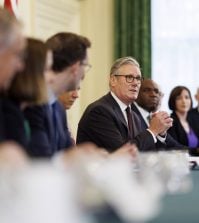Fiscal fictions: what the UK Budget says – and what it omits

On Wednesday, the UK government produced a Budget that made no provision for big public sector pay rises; on Thursday, it promised £5bn to striking NHS staff. Matt Ross explains why this tight Budget may be less brutal for civil service departments than it appears
On Thursday the UK government made a serious pay offer to striking NHS staff, giving ground for the first time in its multi-fronted battle to constrain public sector wage increases. The offer raises hopes of an end to ongoing industrial action by civil servants and health, transport, school and university staff. But with little leeway provided for higher salaries in chancellor Jeremy Hunt’s new Budget – announced just 24 hours before the Department of Health and Social Care’s new pay proposal – it also threatens to further squeeze departmental budgets already reeling from a tight Budget settlement.
The NHS offer includes a one-off payment worth 6% of salaries for 2022-23 – costing about £2.5bn (US$3bn) – and a 5% pay increase during 2023-24. Most unions are recommending that staff vote to accept the deal, which exceeds the forecast CPI inflation rate of 4.1% and matches anticipated private sector pay rises over the coming year.
However, the government has not explained how the rises will be funded. Ben Zaranko, senior research economist at financial think tank the Institute for Fiscal Studies (IFS), suggested that the one-off payments may come out of the Treasury’s £14bn (US$17bn) reserve included in Wednesday’s Budget; but the new 2023-24 offer, worth about £1.5bn (US$1.8bn), may cut into existing NHS budgets. “There must be a risk that the NHS is asked to make heroic efficiency savings to absorb these costs, struggles to do so, and instead has to be bailed out in six months or a year’s time. That would hardly lend itself to sensible financial planning,” said Zaranko.
Government sticks to its fiscal rules… just
If on the other hand the Treasury finds the extra money, he added, “that would be a material alteration to the spending plans contained in Wednesday’s Budget before the ink is dry.” It could also push public spending outside the chancellor’s self-imposed fiscal rules, which his Budget aimed to hit by the narrowest of margins. Hunt has pledged to see debt declining as a share of national income in five years’ time, but his plans envisage a fall over that period of just £6.5bn (US$7.9bn). That’s equivalent to 0.2% of both GDP and the national debt, pointed out Richard Hughes, chair of public finances watchdog the Office of Budget Responsibility (OBR), at an event run by think tank the Institute for Government (IfG) on Thursday.
“To put it into context, the average chancellor against their fiscal rules has had about £25bn (US$30bn) to spare against whatever rule they set for themselves,” said Hughes: Hunt’s £6.5bn headroom “is vanishingly small by comparison with any of the risks or threats that might face the fiscal outlook.”

It is also smaller than the cost of extending the NHS offer to other public sector staff. Matching forecast private sector pay growth during 2023-24 would cost up to £5bn (US$6bn), said the IFS at its own Budget analysis event; offering a backdated, one-off payment to match private sector pay growth during 2022-23 could add £9bn (US$11bn) to the bill. Having just set out a Budget that scrapes inside his fiscal rules, it seems likely that Hunt will expect departments to find much of any money required for pay rises above the 3.5% envisaged under current plans.
The chancellor may be pursuing a “divide and conquer strategy,” commented IfG programme director Nick Davies – giving way to NHS staff, while resisting pay demands from public workers less adored by the British populace. If government does instruct departments to help fund pay rises above 3.5%, however, their post-2025 budgets look fairly horrific.
New spending pledges
Last November’s Autumn Statement envisaged some very tight settlements for central government. The Budget largely retains these overall numbers – but it also promises new childcare funding worth around £9bn (US$11bn) , while Hunt has pledged to increase defence spending to 2.5% of GDP by 2030. If the government keeps international development spending at 0.5% of GDP and maintains NHS budget growth at the long-term average, said IFS deputy director Carl Emmerson, “that would mean cuts of about £18bn [US$22bn], 3.2% a year” for other departments – meaning “pretty deep cuts to areas like local government, further education, courts and prisons.”
This settlement will come as a disappointment to many public servants, who might have expected to share in the windfall generated by improvements in the UK’s economic outlook. The UK is now predicted to avoid a ‘technical’ recession, which requires negative growth for two consecutive quarters: household incomes are set for their greatest squeeze since records began in 1955, but the OBR’s forecast envisages a shallower economic dip than anticipated in November – giving Hunt, coincidentally enough, an unexpected £18bn to spend.
Departments won the odd crumb from this table: HMRC, for example, is to receive £47m (US$57m) to pursue some of the £48bn (US$58bn) it’s owed in outstanding taxes. But Hunt spent much greater sums elsewhere, much of it on childcare, pensions tax relief, and fuel duty.

In a bid to tackle labour shortages, Hunt has promised 30 hours of free weekly childcare to the working parents of kids aged nine months to three years – with a phased roll-out running to 2025. “This is a major expansion of the welfare state,” commented IFS director Paul Johnson, highlighting how childcare spending has changed since the last Labour government began funding early education services in deprived areas. “There’s been a big shift from spending on poor children, to a universal offer for those with working parents,” he said.
On pensions, Hunt lifted the cap on annual tax-free pension contributions by 50%, and abolished the £1m (US$1.2m) lifetime limit. The chancellor positions the £1m cap’s abolition as a way to keep senior doctors at work, and it does address a real problem for NHS employers. But this is “a billion-pound sledgehammer to crack a very small nut,” commented Johnson.
Faced with a similar issue recently regarding judges’ pensions, the government found a much more targeted way to solve the problem. And as IfG chief economist Gemma Tetlow pointed out, in the private sector employees who’ve “exceeded those lifetime allowances will tend to be offered extra pay in lieu of a pension contribution. We could have done something similar.” For Hunt, though, his solution has a further benefit: the £1.3bn (US$1.6bn) giveaway will benefit wealthy Conservative supporters and please the right-wing of his party – keeping the tax-cutting acolytes of short-lived prime minister Liz Truss on side.
On fuel duty, Hunt has maintained the 5p/litre cut and frozen the levy for yet another year, at a cost of £6bn (US$7.3bn). All told, his pension tax cuts and spending pledges commit his entire £18bn windfall – leaving tax as a share of GDP at its highest level since 1950, debt interest costs at a painful 3% of GDP, and debt levels peaking at 95% of GDP. According to the Bank of England’s figures, public debt will sit above 90% until the 2040s.
Perverse incentives
Financial experts are plainly frustrated by Hunt’s decision to spend and give away his £18bn windfall. There’s a “pattern of behaviour in all chancellors that when they get good news, they spend it. And then when they get bad news, they don’t adjust for it,” commented Hughes. As recently as last November, noted Johnson, Hunt was presented with bad economic news – but instead of cutting spending or raising taxes, in the Autumn Statement “he just lived with the extra borrowing. That’s how borrowing ratchets up, year on year.”
What’s more, the chancellor’s fiscal rules have clearly distorted decision-making. As Emmerson pointed out, “there’s a particular weakness of the current target that makes it gameable.” Because the rule promises only that debt will be falling by year four of a five-year forecast, there’s no constraint on spending before then; in fact, borrowing big during earlier years actually makes it easier to hit the target. The chancellor is also incentivised to include unrealistic, medium-term plans for cuts or tax rises that in truth are unlikely to materialise – a form of optimism bias likely to mean that they always hand their successor a worse set of cards than they’ve promised.
As an example, Hunt has frozen fuel duty this year, while including in his Budget inflation-linked rises covering the rest of the spending review period. The problem, as Hughes pointed out, is that every Budget since 2010 has done exactly the same: “It creates in theory lots of revenue in the future, but actually it never arrives,” he said. Over more than a decade, this ongoing freeze has cost the Treasury about £80bn. “The pretence that fuel duties will always rise next year when they never rise this year is becoming increasingly wearisome,” commented Johnson. “It makes a bit of a nonsense of the fiscal forecasts if you can’t even undo a supposedly temporary 5p cut to duty when the price at the pump has fallen by something like 40p.”
Another example lies in the government’s decision to offer big new capital allowances for businesses – compensating for the rise in corporation tax from 19% to 25%. These allowances are limited to three years, commented Tetlow, “because Jeremy Hunt didn’t have the space in the last years of his forecasts to make it a permanent policy.” So while they might encourage businesses to bring forward planned investment, “a lot of the potential benefit to boost long-term UK economic growth, giving business the certainty that this is a government committed to a favourable tax environment for investing businesses, was lost because of a gaming of the fiscal rules.” Johnson sees the same picture: Hunt is “flattering his fiscal books, and causing an absurd amount of uncertainty for companies looking to invest,” he said. “This really is the tale of a badly-designed fiscal rule wagging the dog of fiscal policy.”
Read more: Former UK GDS chief publishes 21 ‘shortcuts’ to ease digital transformation in government
The cuts that never arrive
In these distortions and pretences, though, lies hope for hard-pressed departments – for as Hughes pointed out, Hunt’s fiscal rule also encourages the creation of “fantasy spending plans” for later years of the forecast period. The incentive, said Hughes, is for the chancellor to pretend that in a few years’ time “spending is going to fall, in cash terms or as a share of GDP, when you know full well that’s not consistent with all the policies you’ll want to implement when you get there.”
This is bad news for departmental planning, Hughes pointed out, because finance leaders never have a clear picture of their future income; but it also means that the most eye-watering of the cuts planned from 2025 are unlikely to materialise. Certainly, funding will not be sufficient to prevent further deterioration in public services: by the time of the next election, “services in general are going to be performing worse than they were on the eve of the pandemic, which in almost all cases was worse than they were performing in 2010,” commented Davies. “We are certainly going to be discussing long waiting lists in the NHS, inadequate social care, a shortage of teachers and a crumbling criminal justice system.”
It’s also likely that departments will be required to find a large chunk of any 2023-24 public sector pay settlements. However, if past performance is any measure of future behaviour, then when push comes to shove a post-election chancellor is more likely to allow borrowing to inch yet higher than to impose the punishing cuts set out in Hunt’s Budget from 2025.
The cuts pencilled in for later years “have as much potential of happening as me growing wings and flying around this room,” commented Stephen Bush, an associate editor at the Financial Times. “But neither party really wants to touch that this side of the election”: the Conservatives would rather maintain the fiction that they’re solving the UK’s public finance problems, while Labour has no interest in scaring the public by talking about post-election tax rises.
The government could have made the NHS pay offer alongside its Budget, added Bush – but it wanted to spend the day talking about having avoided a recession, not having folded on public sector pay. Instead, it published a Budget that it knew would be quickly overtaken by events, with post-2025 figures that Bush called “pure fiction, in many ways.” By the autumn, he predicted, departments will have extra money to boost salaries.
Johnson agreed. “It is simply implausible that there will not be extra money available,” he said. “You cannot keep cutting the pay of teachers, nurses and civil servants, both in real terms and relative to the private sector, without consequences for recruitment, retention, service delivery, morale and strikes.”
“The argument that this is not affordable founders on the fact that Mr Hunt found £20bn [US$24bn] a year yesterday for other things,” Johnson concluded. “This is a question of choices and priorities.”
Read more: Details emerge of UK civil service job cuts – but minister backs away from 91,000 target
Want to write for GGF? We are always looking to hear from public and civil servants on the latest developments in their organisation – please get in touch below or email [email protected]






















